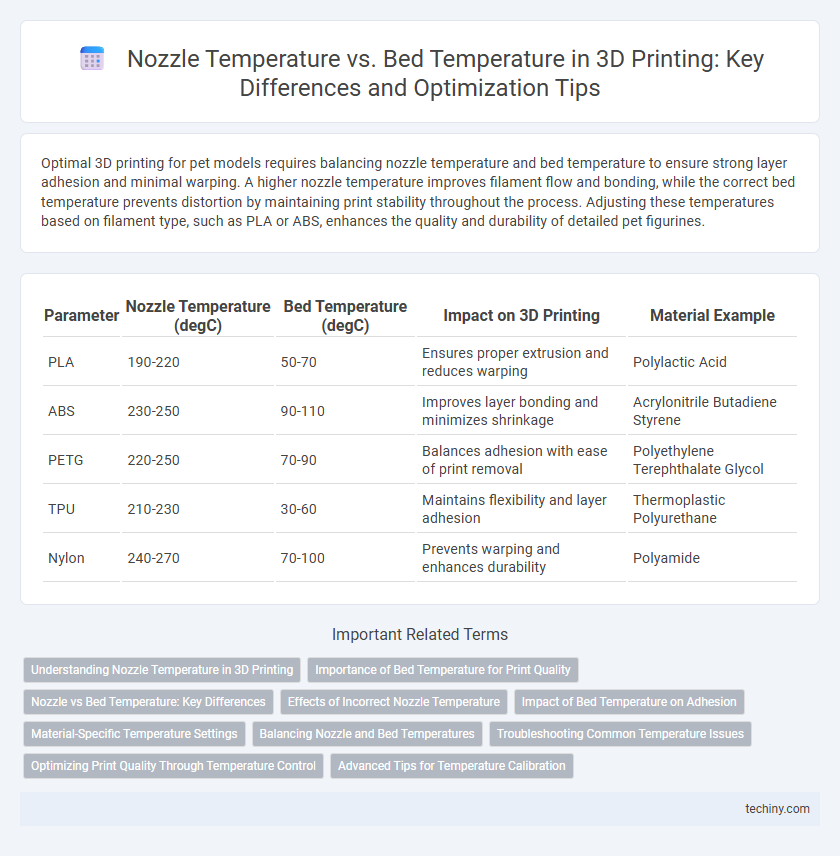Optimal 3D printing for pet models requires balancing nozzle temperature and bed temperature to ensure strong layer adhesion and minimal warping. A higher nozzle temperature improves filament flow and bonding, while the correct bed temperature prevents distortion by maintaining print stability throughout the process. Adjusting these temperatures based on filament type, such as PLA or ABS, enhances the quality and durability of detailed pet figurines.
Table of Comparison
| Parameter | Nozzle Temperature (degC) | Bed Temperature (degC) | Impact on 3D Printing | Material Example |
|---|---|---|---|---|
| PLA | 190-220 | 50-70 | Ensures proper extrusion and reduces warping | Polylactic Acid |
| ABS | 230-250 | 90-110 | Improves layer bonding and minimizes shrinkage | Acrylonitrile Butadiene Styrene |
| PETG | 220-250 | 70-90 | Balances adhesion with ease of print removal | Polyethylene Terephthalate Glycol |
| TPU | 210-230 | 30-60 | Maintains flexibility and layer adhesion | Thermoplastic Polyurethane |
| Nylon | 240-270 | 70-100 | Prevents warping and enhances durability | Polyamide |
Understanding Nozzle Temperature in 3D Printing
Nozzle temperature in 3D printing directly influences the melting and extrusion quality of filament materials like PLA, ABS, and PETG, typically ranging between 190degC and 250degC. Precise control of nozzle temperature ensures optimal layer adhesion and prevents common issues such as stringing or clogging, enhancing print resolution and strength. Unlike bed temperature, which mainly affects print adhesion and warping, nozzle temperature critically dictates the flow characteristics and surface finish of the printed object.
Importance of Bed Temperature for Print Quality
Maintaining an optimal bed temperature is crucial for successful 3D printing as it ensures proper adhesion of the first layer, preventing warping and improving overall print stability. While nozzle temperature controls filament extrusion and flow, bed temperature directly influences the cooling rate and bonding strength between the print and build platform. Proper bed temperature settings, typically between 50degC and 70degC for PLA and higher for ABS or PETG, significantly enhance dimensional accuracy and minimize defects.
Nozzle vs Bed Temperature: Key Differences
Nozzle temperature directly affects filament melting and extrusion quality, while bed temperature ensures proper adhesion and prevents warping during printing. The nozzle operates at higher temperatures, typically between 190degC and 250degC for common materials like PLA and ABS, whereas the bed temperature ranges from 50degC to 110degC depending on the filament type. Maintaining optimal temperature settings for both ensures precise layer bonding, dimensional accuracy, and overall print quality in 3D printing processes.
Effects of Incorrect Nozzle Temperature
Incorrect nozzle temperature in 3D printing can cause poor filament extrusion, leading to under-extrusion or oozing, which affects print quality and layer adhesion. If the nozzle temperature is too low, filament may not melt properly, resulting in clogging and weak layers, while excessively high temperatures can cause stringing and material degradation. Maintaining the optimal nozzle temperature relative to the bed temperature ensures proper bonding and dimensional accuracy in the final print.
Impact of Bed Temperature on Adhesion
Bed temperature plays a critical role in enhancing print adhesion by maintaining the first layer's warmth, which prevents warping and ensures better bonding between the filament and build surface. Optimal bed temperature varies depending on filament type, with common ranges being 50-60degC for PLA and 90-110degC for ABS, directly influencing layer stability and print quality. Consistent heat from the bed reduces internal stresses, minimizing print failure caused by detachment during the printing process.
Material-Specific Temperature Settings
Optimal 3D printing results depend on balancing nozzle temperature and bed temperature according to the filament type. For PLA, the nozzle temperature typically ranges from 190degC to 220degC, with bed temperatures around 50degC to 70degC to improve adhesion. ABS requires higher settings, with nozzle temperatures between 230degC and 260degC and bed temperatures from 90degC to 110degC to prevent warping and ensure proper layer bonding.
Balancing Nozzle and Bed Temperatures
Balancing nozzle temperature and bed temperature is crucial for achieving optimal 3D print quality, as the nozzle temperature affects filament extrusion and layer adhesion, while the bed temperature influences first-layer bonding and warping prevention. For PLA filament, maintaining a nozzle temperature around 200-220degC and a bed temperature between 50-60degC ensures strong adhesion without overheating. Adjusting these settings based on material properties like ABS or PETG helps minimize defects such as stringing or warping, improving overall print reliability and surface finish.
Troubleshooting Common Temperature Issues
Proper nozzle temperature is crucial for filament extrusion consistency, while bed temperature ensures optimal adhesion and minimizes warping during 3D printing. Common temperature issues include under-extrusion caused by nozzle temperatures set too low and poor bed adhesion resulting from insufficient bed heating. Adjusting the nozzle temperature within the recommended range for the filament type and maintaining a stable, correctly heated bed surface can significantly improve print quality and reduce defects.
Optimizing Print Quality Through Temperature Control
Optimizing print quality in 3D printing requires precise control of nozzle and bed temperatures, as the nozzle temperature affects filament extrusion consistency while the bed temperature ensures proper adhesion and minimizes warping. Different materials like PLA, ABS, and PETG have specific temperature ranges--PLA typically prints best with a nozzle at 190-220degC and a bed at 50-70degC, while ABS requires higher settings often around 230-250degC for the nozzle and 90-110degC for the bed. Fine-tuning these parameters based on filament specifications and printer capabilities leads to enhanced layer bonding, reduced defects, and overall improved print accuracy.
Advanced Tips for Temperature Calibration
Precise nozzle temperature control between 190degC and 250degC ensures optimal filament extrusion and layer adhesion, while bed temperature settings from 50degC to 110degC enhance first-layer bonding and minimize warping in advanced 3D printing. Fine-tuning temperatures based on specific filament types like PLA, ABS, or PETG is crucial for achieving dimensional accuracy and surface finish. Implementing temperature towers and live temperature adjustments during printing enables real-time calibration, improving overall print quality and reliability.
Nozzle Temperature vs Bed Temperature Infographic

 techiny.com
techiny.com